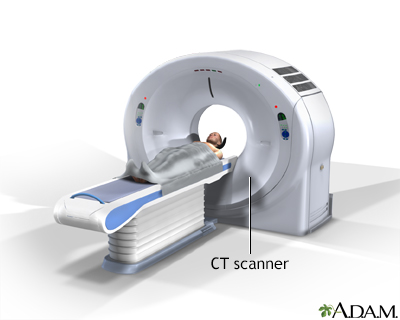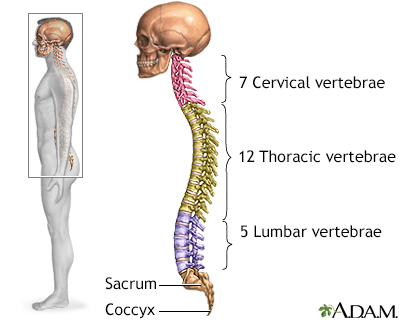Cervical spine CT scan
CAT scan of cervical spine; Computed axial tomography scan of cervical spine; Computed tomography scan of cervical spine; CT scan of cervical spine; Neck CT scan
A computed tomography (CT) scan of the cervical spine makes cross-sectional pictures of the neck. It uses x-rays to create the images.
Images


How the Test is Performed
You will lie on a narrow table that slides into the center of the CT scanner.
Once you are inside the scanner, the machine's x-ray beam rotates around you. Modern "spiral" scanners can perform the exam without stopping.
A computer creates separate images of the body area, called slices. These images can be stored, viewed on a monitor, or printed on film. Three-dimensional models of the cervical spine can be created by adding the slices together.
You must be still during the exam. Movement can cause blurred images. You may need to hold your breath for short periods of time.
The scan takes 10 to 15 minutes.
How to Prepare for the Test
Some exams use a special dye, called contrast that is put into your body before the test starts. Contrast helps certain areas show up better on the x-rays.
Contrast can be given in different ways:
- It may be given through a vein (IV) in your hand or forearm.
- It may be given as an injection into the space around the spinal cord.
If contrast is used, you may also be asked not to eat or drink anything for 4 to 6 hours before the test.
Let your health care provider know if you have ever had a reaction to contrast. You may need to take medicines before the test to avoid this problem.
Before having the contrast, tell your provider if you take the diabetes medicine metformin (Glucophage). You may need to take extra steps before the test if you take this drug.
Too much weight can cause damage to the scanner's working parts. Find out if the CT machine has a weight limit if you weigh more than 300 pounds (135 kilograms).
You will wear a hospital gown during the study. You will need to take off all jewelry as metal can affect the CT images.
How the Test will Feel
Some people may have discomfort from lying on the hard table.
Contrast given through an IV may cause a slight burning feeling, a metal taste in the mouth, and a warm flushing of the body. These feelings are normal and go away in a few seconds.
Why the Test is Performed
CT makes detailed pictures of the body very quickly. The test may help look for:
- Birth defects of the cervical spine in children
- Spine problems, when a spine MRI cannot be used
- Injury to the upper spine
- Bone tumors or cancers
- Fracture of a spine bone
- Disk herniations and compression of the spinal cord
- Healing problems or scar tissue following surgery
Normal Results
Results are considered normal if the cervical spine looks OK.
What Abnormal Results Mean
Abnormal results may be due to:
- Degenerative changes due to age
- Birth defects of the cervical spine
- Bone problems
- Fracture
- Osteoarthritis
- Disk herniation
- Healing problems or growth of scar tissue after surgery
- Deformity from previous surgery or injuries
Risks
Risks of CT scans include:
- Being exposed to radiation
- Allergic reaction to contrast dye
- Birth defect if done during pregnancy
CT scans expose you to more radiation than regular x-rays. Having many x-rays or CT scans over time may raise your risk for cancer, but the risk from any one scan is small. Talk to your provider about this risk and how it weighs against the benefits of the test.
Some people have allergies to contrast dye. Let your provider know if you have ever had an allergic reaction to injected contrast dye.
- The most common type of contrast given into a vein contains iodine. If a person with an iodine allergy is given this type of contrast, nausea or vomiting, sneezing, itching, or hives may occur.
- If you must have this type of contrast, you may get antihistamines (such as Benadryl) or steroids before the test.
- The kidneys help remove iodine out of the body. People with kidney disease or diabetes may need to get extra fluids after the test to help flush the iodine out of the body.
Rarely, the dye may cause a life-threatening allergic response called anaphylaxis. If you have any trouble breathing during the test, you should notify the scanner operator immediately. Scanners come with an intercom and speakers, so the operator can hear you at all times.
References
Kapoor G, Toms AP. Current status of imaging of the musculoskeletal system. In: Adam A, Dixon AK, Gillard JH, Schaefer-Prokop CM, eds. Grainger & Allison's Diagnostic Radiology. 7th ed. Philadelphia, PA: Elsevier; 2021:chap 38.
Shimer AL, Aghdasi B. Traumatic injuries of the cervical spine in the athlete. In: Miller MD, Thompson SR, eds. DeLee, Drez,& Miller's Orthopaedic Sports Medicine. 5th ed. Philadelphia, PA: Elsevier; 2020:chap 128.
Williams KD. Fractures, dislocations, and fracture-dislocations of the spine. In: Azar FM, Beaty JH, eds. Campbell's Operative Orthopaedics. 14th ed. Philadelphia, PA: Elsevier; 2021:chap 41.
BACK TO TOPReview Date: 4/24/2023
Reviewed By: C. Benjamin Ma, MD, Professor, Chief, Sports Medicine and Shoulder Service, UCSF Department of Orthopaedic Surgery, San Francisco, CA. Also reviewed by David C. Dugdale, MD, Medical Director, Brenda Conaway, Editorial Director, and the A.D.A.M. Editorial team.

Health Content Provider
06/01/2025
|
A.D.A.M., Inc. is accredited by URAC, for Health Content Provider (www.urac.org). URAC's accreditation program is an independent audit to verify that A.D.A.M. follows rigorous standards of quality and accountability. A.D.A.M. is among the first to achieve this important distinction for online health information and services. Learn more about A.D.A.M.'s editorial policy, editorial process and privacy policy. A.D.A.M. is also a founding member of Hi-Ethics. This site complied with the HONcode standard for trustworthy health information from 1995 to 2022, after which HON (Health On the Net, a not-for-profit organization that promoted transparent and reliable health information online) was discontinued. |
The information provided herein should not be used during any medical emergency or for the diagnosis or treatment of any medical condition. A licensed medical professional should be consulted for diagnosis and treatment of any and all medical conditions. Links to other sites are provided for information only -- they do not constitute endorsements of those other sites. © 1997- 2024 A.D.A.M., a business unit of Ebix, Inc. Any duplication or distribution of the information contained herein is strictly prohibited.
